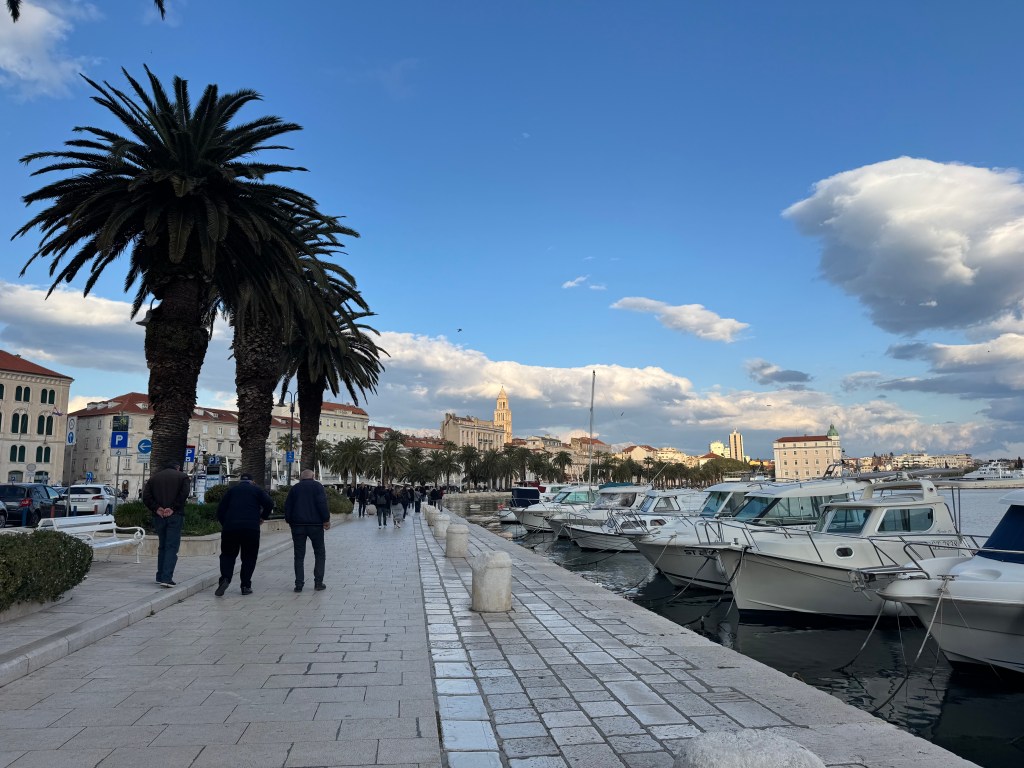“Have you considered Croatia?” I asked a friend recently who said she is planning a trip to Portugal this fall.
It was a bold alternative and an itinerary zigzag, but one I wanted to suggest after vacationing in both countries. Croatia has all the advantages that Portugal (and Spain and Italy as well) boasts: coastline, cuisine and viticulture. Plus there’s amazing history, jet-setting locations, regional festivals and island-hopping to boot.
I spent a week exploring the central Dalmatia coast earlier this year on a travel invite from the Croatian National Tourist Board. It was my second visit to the country. The first was about a decade ago on a family trip with two teenagers and my husband. Tourism has changed significantly in the years between both trips — Croatia is much more popular today, especially with the cruise-ship clientele — but the country is still one of my top recommendations for a European destination. Here’s a look at the land.
History Lesson
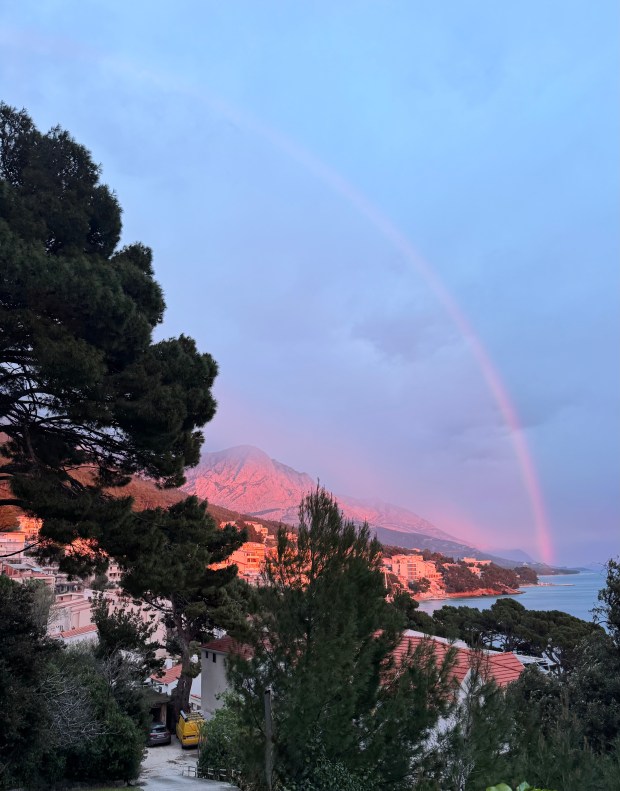 A rainbow in Brela, Croatia, which is famous for its seashell-white pebble beach. (Courtesy of Amy Nelson)
A rainbow in Brela, Croatia, which is famous for its seashell-white pebble beach. (Courtesy of Amy Nelson)
First a bit of history about Croatia. Under Roman rule, the area was called Dalmatia until it became its own kingdom in 925. Over the centuries, it experienced a number of conquests, mergers and name changes, most recently becoming part of Yugoslavia in 1918 after the collapse of the Austria-Hungry alliance at the end of World War I.
After World War II, it continued to be part of socialist Yugoslavia, but in 1991, Croat forces that had declared independence from Yugoslavia fought against the Serb-controlled Yugoslav People’s Army and local Serb forces for secession in the Croatian War of Independence. As that war started, the adjacent lands of Bosnia and Herzegovina, Slovenia and Macedonia also seceded, effectively ending Yugoslavia as a nation. In 1995 (just three decades ago), Croatia emerged with its independence and defined
borders, but was heavily damaged economically and physically from the war.
Modern-day Croatia is considered part of the Balkan Peninsula and is comprised of four regions: Dalmatia is the largest and is along the coastline, but there’s also Croatia Proper, which includes the capital Zagreb, along with inland Slavonia and the most northwestern region of Istria. Despite the growing interest in the destination, there are no direct flights from the Twin Cities (yet). In fact, Visit Croatia reports that there’s only one direct flight to the entire country, and that’s out of New York. Most Minnesota flights into Zagreb or other popular sites, including Split and Dubrovnik, connect through Amsterdam.
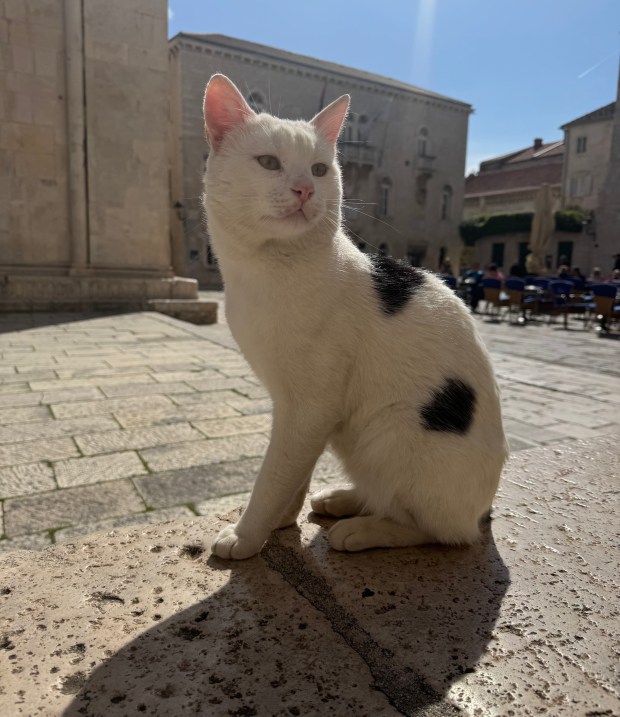 A cat in Trogir, Croatia. (Courtesy of Amy Nelson)
A cat in Trogir, Croatia. (Courtesy of Amy Nelson)
On my first visit to Croatia, we started in Italy and drove the entire Adriatic Sea coastline, beginning in Venice with stops in Slovenia and the tiny 12-mile slice of Bosnia and Herzegovina called the Neum corridor, which touches the water north of Dubrovnik. Since that first visit, the Peljesac Bridge opened in 2022 to bypass Bosnia and quickly connect Split and Dubrovnik. Friends who visited Croatia last summer said they wanted to enjoy the entire coastline and took the bridge for scenic views, but I was excited to stop for a pizza lunch in Bosnia back in the day and add it to the countries I had visited (albeit for only a few hours).
Speaking of coastlines, one oddity about Croatia is its lack of a robust train service, which is a common way to explore other European countries. Some buses criss-cross the country, but most visitors choose to rent a car to explore the sights and sites at their leisure. For people not comfortable driving in foreign countries, the transportation limitations may be frustrating or expensive if they choose to hire a driver.
Another option is to explore by boat, which is what a different friend is planning to do this fall. She and her family are renting a catamaran for almost two weeks to sail the coast and visit Croatia’s islands, including Hvar, Brac and Korkula. Visitors arriving by cruise ship likely will have port calls in Split and Dubrovnik and will need to arrange a rental car or ride-share if they want to explore the country beyond the coastal areas.
Croatia was once an amazingly affordable country with its own currency, the kuna, as it slowly recovered from the war. During our first visit, we paid $28 for last-minute rooms on a boat hotel in Rijeka and less than $20 for private rooms in a family home advertised on a handmade sign near Split. Today, you’ll need more than good luck to find those alternative and cheap lodging options. Prices soared after Croatia started using the euro in 2023, a tourism official told me, making it difficult for some residents to maintain the standard of living they had finally established after the dissolution of Yugoslavia.
Still, short-term rentals and campgrounds supplement hotel chains for lodging options that range from budget to luxury-plus. During my visit this year, construction crews along the coast from Split to Brela were busy building apartment buildings and hotels as close as possible to the beaches and marinas.
Zagreb to Split
Croatia is a narrow country, approximately 3,500 miles long, which makes starting in the north and heading south along the Adriatic coastline – or reversing the order – a straightforward itinerary. But that doesn’t take into account the nearly 1,200 islands and reefs that dot the journey and make for ideal day trips on ferry rides or chartered boats.
Budget-friendly in-country flights can help save on travel time, too. The same friends who drove the country last summer decided to drop off their rental car in Dubrovnik and fly one-way back to Zagreb, amused to be on the same cramped flight with the exceptionally tall members of the Croatian men’s basketball team.
My suggested itinerary is to start in Zagreb. The metro area of about 1 million people feels modern and lively, despite its millennium-old history. The central square, called Ban Jelacic Square, is a popular hot spot with cafes and shops and monuments. The Museum of Broken Relationships is a quirky attraction for those who like oddities and Atlas Obscura spots, while the Zagreb Cathedral is worthy stop for travelers who like to visit the many, many European churches.
From Zagreb, make the three-hour drive to Plitvice Lakes National Park for some breathtaking scenery, amazing waterfalls and moderate hiking. The 115 square miles of park feature 16 cascading lakes that change in color from radiant turquoise to emerald
green to flat grey based on the mineral deposits within them. In some areas, the vibrant blue water is clear enough to see the lake bottom and the fish and vegetation living underneath the surface. We spent a full day exploring the park’s wooden walkways and designated hiking trails as well as taking a boat ride to view some of the tallest waterfalls. Be aware, however, this UNESCO World Heritage site (and Croatia in general) has been “discovered” and is very crowded throughout the year.
Overtourism throughout Croatia was the focus of several news stories earlier this year and the Croatian National Tourist Board reported record-breaking tourism numbers in 2024 with over 21.3 million arrivals and 108.7 million overnight stays. Visiting during the off-season is an option, although I found several shops, restaurants and hotels are closed then.
Split and Surroundings
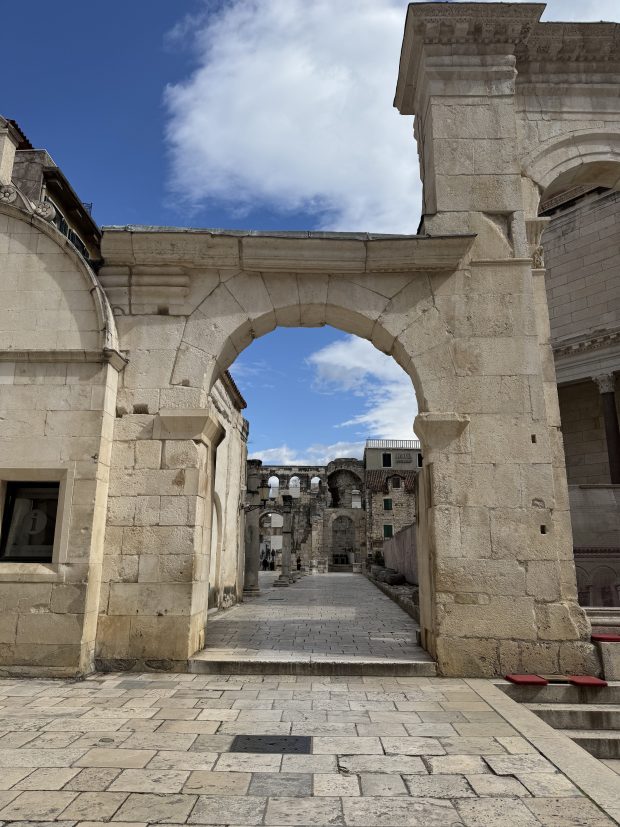 Diocletian’s Palace in Split, Croatia. (Courtesy of Amy Nelson)
Diocletian’s Palace in Split, Croatia. (Courtesy of Amy Nelson)
From Plitvice, travelers can head west to Zadar, the oldest continuously inhabited city in Croatia and often overlooked as a destination, or southwest to Split, the second most populous, like we did. Both are on the Adriatic Sea. Split is a must-visit for all itineraries in Croatia. Skipping it would be like going to France but bypassing Paris.
Although Split was originally founded by the Greeks nearly 2,500 years ago, it’s the Roman ruins that Emperor Diocletian built in the 4th century as his retirement palace that dominate the city’s Old Town region. The attraction is called Diocletian’s Palace and it’s a sprawling maze of streets enclosed by stone walls and massive gates across several city blocks. Inside, the fortress is packed with fascinating cellars, churches, alcoves and open-air architecture. The UNESCO World Heritage site (yes, yet another one) offers shops, attractions, restaurants and history – with residents still living full-time inside the motor-free fortress.
The best way to explore the palace is to hire a guide who can explain the history and the mysterious back alleys and hidden gems. Plan on at least four hours of walking, with time to stop for a meal or shopping. You can explore some areas for free on your own, but on my multiple visits, I found that paying for entry to the private areas offered more insight. We made sure to take photos of the halls where episodes of “Game of Thrones” were filmed and marveled at how advanced the construction of the palace was for that era. Grab a fresh seafood dinner, a glass of Croatian wine or an indulgent gelato inside the palace walls or outside along the Riva,
or waterfront promenade.
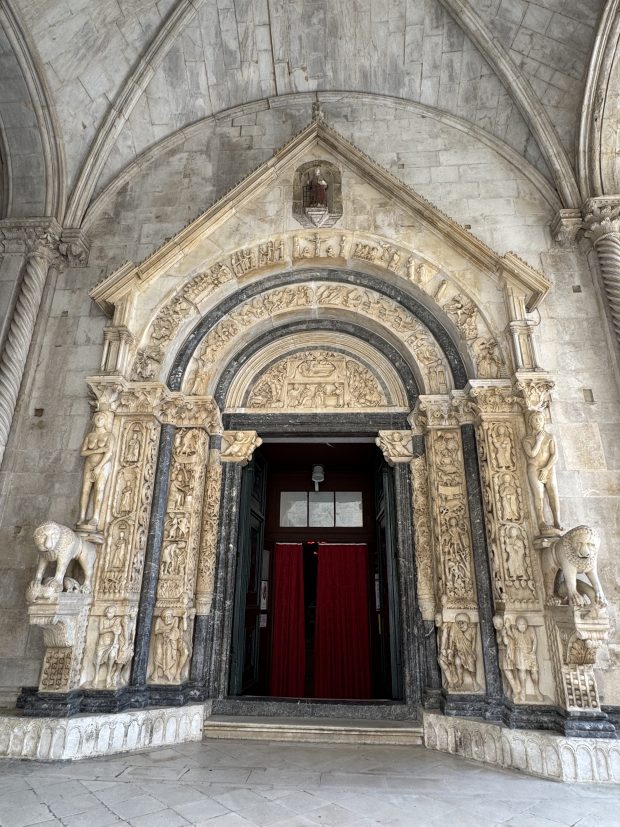 The carved door at Trogir Cathedral in Croatia. (Courtesy of Amy Nelson)
The carved door at Trogir Cathedral in Croatia. (Courtesy of Amy Nelson)
Atlas Obscura fans should be sure to rub the big toe of the Gregory of Nin statue and don’t miss Froggyland, a quirky yet fascinating museum dedicated to taxidermied frogs in 21 different dioramas. It’s small, but remarkably detailed, with hundreds of stuffed frogs arranged in various daily-life activities. My favorites were a circus scene and a courtroom trial.
Split makes for an excellent home base for day trips, and we took several this spring. A quick 30-minute drive to the north is Trogir and its historic walled city center that feels a bit like Diocletian’s Palace on a smaller scale. We spent a few hours exploring the winding stone streets, as well as the Cathedral of St. Lawrence and its famous intricately carved door finished in 1240 by Croatian architect and sculptor Master Rodovan and his apprentices.
A different day, we traveled an hour south for an overnight stay in the tiny town of Brela, famous for a seashell-white pebble beach, local lavender farms and the Biokovo Mountain Nature Park. We ate dinner at Konoba Feral (it was so good we returned a second night) and admired the creative cuisine, including the shrimp black risotto, daily fresh catch and panna cotta dessert.
Later, we drove from Brela about an hour to inland Sinj, a tiny gem of a town immensely proud of its history. More than 300 years ago in 1715, the townspeople stopped an advancing Ottoman Empire in an underdog battle. To commemorate, the town holds a knights’ tournament called Sinjska Alka that attracts people from across Europe every first Sunday of August. A modern, interactive (and thankfully air-conditioned) museum in the heart of the town educates visitors about the original battle and the annual equestrian festival with a 20-minute film, full-size armored soldiers on horseback and rooms upon rooms of costumes and weapons. Sinj struck me as one of those places famous for one large community event — like Pamplona and its running of the bulls. It is also easy to overlook because it’s not on the cruise-ship circuit or along the main highway.
Another location worth the drive but not on most itineraries is Imotski, on the other side of Biokovo Mountain from Brela. Here, we hiked around the Blue and Red Lakes (technically sinkholes), both aptly named for their topography. The Blue Lake was a
striking, shimmering turquoise blue while the Red Lake is named for the steep red cliffs surrounding it and not for the color of the water deep inside.
Destination Dubrovnik
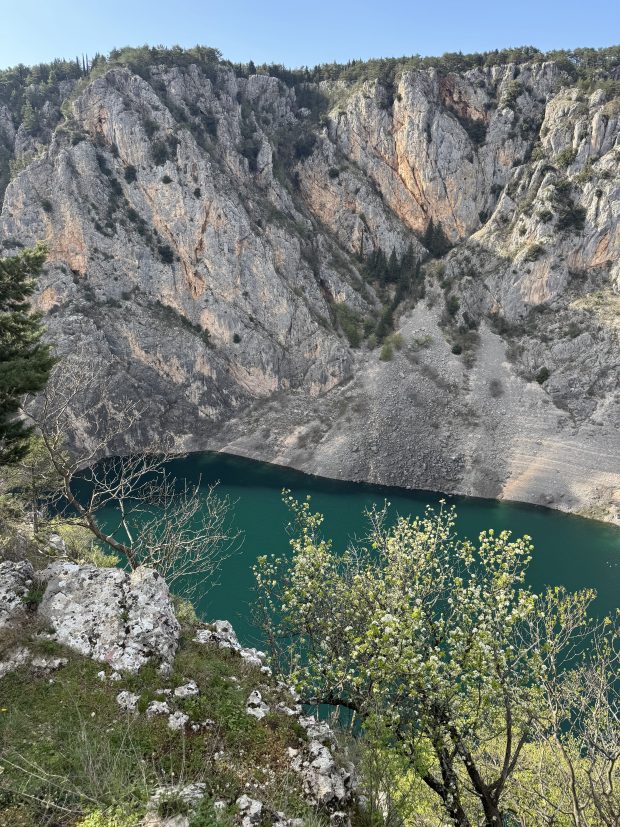 The Blue Lake in Imotski, Croatia. (Courtesy of Amy Nelson)
The Blue Lake in Imotski, Croatia. (Courtesy of Amy Nelson)
Finally, the southern-most must-see along Croatia’s Adriatic Sea coast is the city of Dubrovnik. “Game of Thrones” fans will instantly recognize those medieval city walls, which we walked along one hot summer day on my first visit to the country. As the setting for “GoT”’s King’s Landing, Dubrovnik offers Instagramable stops at every turn.
When we visited, the city was starting to become popular, but not so overcrowded that it was difficult to navigate. We stayed several nights outside the gates of Old Town and knew to avoid the main sites along the stradun — or main pedestrian street — during the day when the cruise ships docked.
Instead, we took the cable car to the top of Srd Hill for a panoramic view one afternoon and lounged on the beach outside those medieval walls another day. Then we returned to the Old Town at dusk to discover a memorable pizza with a fried egg on top at Pizzeria Mirakul followed by a visit to the famous Buza Bar precariously stacked along the outer wall right above the sea.
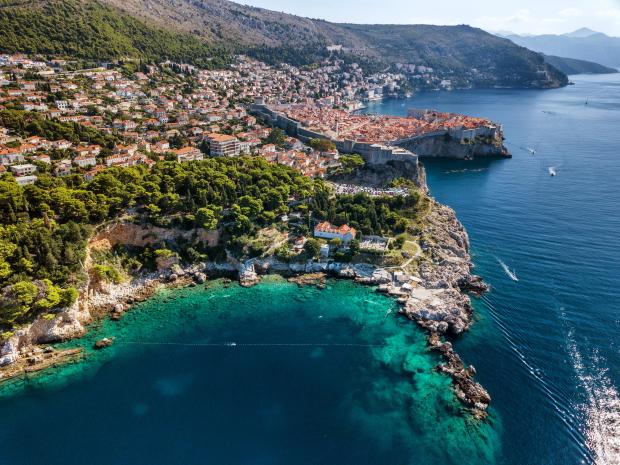 The coastline in Dubrovnik, Croatia. (Aleksandar Gospic / Courtesy of the Croatian National Tourist Board)
The coastline in Dubrovnik, Croatia. (Aleksandar Gospic / Courtesy of the Croatian National Tourist Board)
Croatia is also famous for its island hopping, which, unfortunately, I haven’t yet experienced. We were scheduled to take the ferry from Markarska to Brac Island this spring, but the winds were too strong for safe ferry passage. I was a bit worried about
getting seasick on the ferry, so was a bit relieved to explore Markarska instead. Korčula and Hvar Island are two of the most popular destinations with ferry rides from both Dubrovnik and Split. Korčula also is a medieval walled city and known as the birthplace of Marco Polo, while Hvar has wineries, beaches and upscale dining and shopping.
I’m not sure yet if I convinced my friend to alter her plans and visit Croatia instead of Portugal this fall but I was able to offer some suggestions to the friend renting the catamaran. She messaged me this spring after seeing some of my social media posts
from Croatia and we met for dinner to discuss. I’m confident she’ll find Croatia as charming as I do.
Wines of Croatia
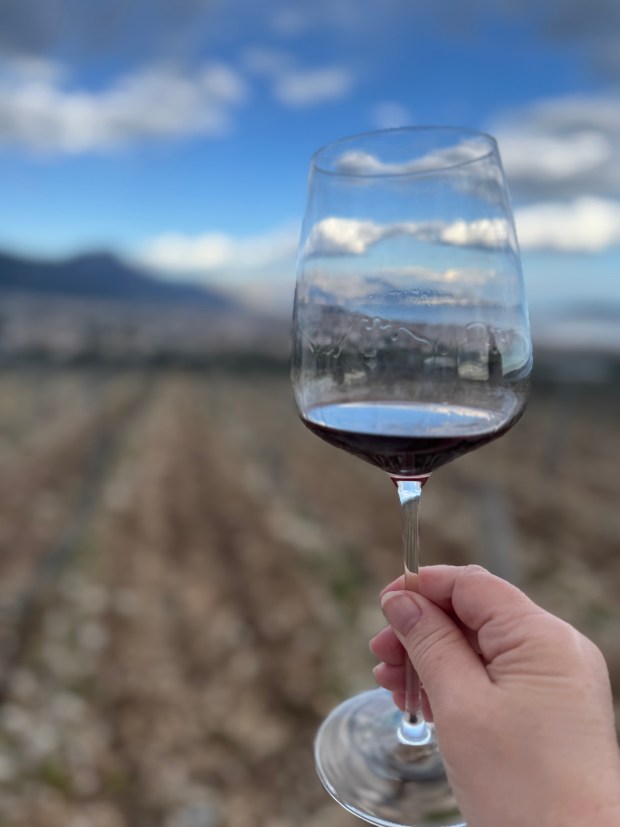 The author holds a glass of wine in the Kastel Sikuli vineyard in the Rudine region near Split, Croatia. (Courtesy of Amy Nelson)
The author holds a glass of wine in the Kastel Sikuli vineyard in the Rudine region near Split, Croatia. (Courtesy of Amy Nelson)
Many parts of Europe are known for their award-winning wines, particularly France, Italy and Spain. But few may know the role a Croatian played in putting California wines on the map and his impact in his home country’s viticulture. Miljenko “Mike” Grgich is a national hero known for escaping his poor upbringing as the son of winemaker in Croatia by eventually landing in Napa Valley, California, where he created the 1973 Chateau Montelena Chardonnay. That varietal shocked the world when it won the Judgment of Paris blind tasting in 1976. The 2008 movie “Bottle Shock” is a fictionalized comedy of the event that stars Alan Rickman and Chris Pine but fails to credit Grgich’s contributions. Grgich ran Grgich Hills Estate in California until 2018 and
died in his sleep at age 100 in 2023.
As part of my hosted trip to Croatia this spring, I was invited to attend the Dalmatian Wine Festival in Split to learn about the various wineries operating in the region. Grgich was a native of Desne, in Dalmatia, and his name was cited often as inspiration. Pošip is the area’s take on Chardonnay, while Plavac Mali is a popular red varietal. I sampled nearly 50 types and labels over the two-day festival and was also treated to samplings at the Hvar Hills and Markus tasting rooms in Split and a gourmet lunch with wine pairings one afternoon at Kastel Sikuli vineyard outside of Split. Although most Croatian wines aren’t yet distributed in the United States, some Twin Cities restaurants are starting to add these labels to their menus. Or do as my friend is planning this fall and schedule a day of wine tastings and vineyard visits as part of a trip to Croatia.
